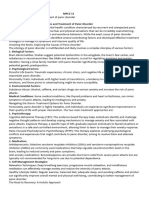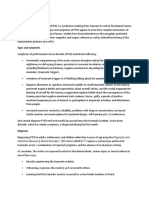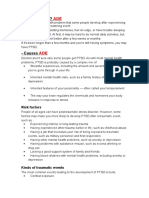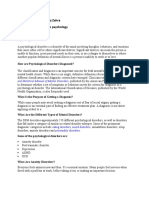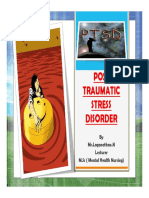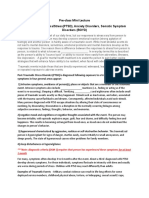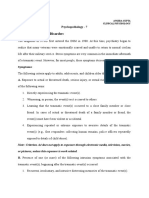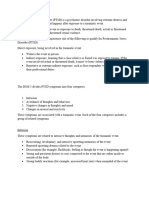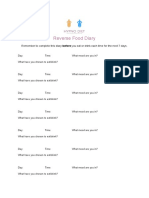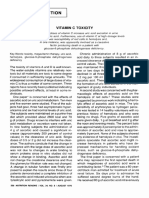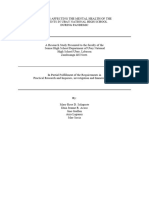Ies R
Ies R
Uploaded by
John PrestonCopyright:
Available Formats
Ies R
Ies R
Uploaded by
John PrestonOriginal Title
Copyright
Available Formats
Share this document
Did you find this document useful?
Is this content inappropriate?
Copyright:
Available Formats
Ies R
Ies R
Uploaded by
John PrestonCopyright:
Available Formats
Top tips for Post Traumatic Stress Disorder
Why Post-traumatic Stress Disorder is a delayed and/or protracted response to a stressful event or
situation of an exceptionally threatening or catastrophic nature, which is likely to cause extreme
distress in almost anyone.
The lifetime prevalence rate of PTSD is between 5% to10%.
The onset of symptoms is usually in the first month after the traumatic event, but in a minority
(less than 15%; McNally, 2003) there may be a delay of months or years before symptoms start
to appear
How Typical symptoms include
• Re-experiencing the trauma through intrusive thoughts and nightmares,
• Intense distress when confronted with triggers;
• Avoidance of stimuli associated with the trauma;
• Signs of heightened irritability such as sleep disturbance,
• Hyper-arousal, loss of impulse control
• Emotional numbing and amnesia for significant parts of the event
• Feelings of panic and fear
• Depression
• Anger
• Unexplained physical symptoms: muscle aches, diarrhoea, palpitations, headaches
Symptoms are worse if
• It happens at an early age – the earlier the age, the worse the trauma
• It is caused by a parent or other care giver
• The trauma is severe
• The trauma goes on for a long time
• If the person is isolated
• If the person is still in touch with the abuser and/or threats to their safety.
Sufferers may also develop further, secondary psychological disorders as complications of the
PTSD such as
• Substance misuse disorders,
• Depression including the risk of suicide,
• Anxiety disorders including panic attacks
Scoring questionnaire: Impact of Events Scale - Revised (IES-R) (see over)
Scoring: Mean scores are calculated for the whole scale and for each subscale. IAPT suggests a
cut-off score of 33 or above.
What Mild symptoms which have been present for less than 4 weeks - watchful waiting with follow up
next? within a month
NICE guidelines http://www.nice.org.uk/CG26 suggest that trauma-focussed psychological
therapies (CBT or EMDR, Eye Movement Desensitisation and Reprocessing) should be offered
before medication (SSRIs), wherever possible. However, the level of impairment does correlate
well with depression, and therefore would be indicated if this is associated
There is a morbid PTSD form that resembles Borderline Personality Disorder and may well be
linked to early abuse but can be triggered by later trauma (it is sometimes called Complex
PTSD). The condition also has links with ME/CFS and patients often end up on a number of
medications and extensive therapy and are at high risk for iatrogenic issues.
Web- Self help patient information leaflets:
links Royal College of Psychiatrists
http://www.rcpsych.ac.uk/mentalhealthinfo/problems/ptsd/posttraumaticstressdisorder.aspx
MIND
http://www.mind.org.uk/help/diagnoses_and_conditions/post-traumatic_stress_disorder
Who Dr Caroline Lea-Cox CCG Clinical Lead for Mental Health and Learning Disability
are GP Mental Health and Learning Disability Network CCG NHS Cambridgeshire and Peterborough;
you? Dr Chess Denman Medical Director CPFT;
Martin Liebenberg Counselling Psychologist CPFT August 2012
impact of event scale - revised
your name: today’s date:
on _______ you experienced ________________ how distressing?
(date) (life event)
below is a list of difficulties people sometimes have not a little moder quite extre
after stressful life events. please read each item and at all bit -ately a bit -mely
then indicate how distressing each difficulty has been
for you during the past 7 days or other agreed time: 0 1 2 3 4
a. any reminder brought back feelings about it
b. I had trouble staying asleep
c. other things kept making me think about it
d. I felt irritable and angry
I avoided letting myself get upset when
e. I thought about it or was reminded of it
f. I thought about it when I didn't mean to
g. I felt as if it hadn't happened or it wasn't real
h. I stayed away from reminders about it
i. pictures about it popped into my mind
j. I was jumpy and easily startled
k. I tried not to think about it
I was aware that I still had a lot of feel-
l. ings about it, but I didn't deal with them
m. my feelings about it were kind of numb
I found myself acting or feeling
n. like I was back at that time
o. I had trouble falling asleep
p. I had waves of strong feelings about it
q. I tried to remove it from my memory
r. I had trouble concentrating
reminders of it caused me to have phys-
s. ical reactions, such as sweating, trouble
breathing, nausea. or a pounding heart
t. I had dreams about it
u. I felt watchful and on-guard
v. I tried not to talk about it
avoidance subscale (total of e, g, h, k, l, m, q, v divided by 8) =
intrusion subscale (total of a, b, c, f, i, n, p, t divided by 8) =
hyperarousal subscale (total of d, j, o, r, s, u divided by 6) =
Weiss,D.S. & Marmar,C.R. The impact of event scale-revised. in Wilson,J.P. & Kean,T.M. (eds.)
Assessing psychcological trauma and PTSD: a practitioner’s handbook (ch 15). N.Y: Guildford, 1995.
You might also like
- Practical Genetic Counseling For The Laboratory - (8. Genetic Counselor Role in Laboratory Case Management)Document20 pagesPractical Genetic Counseling For The Laboratory - (8. Genetic Counselor Role in Laboratory Case Management)Hematology I Hematology INo ratings yet
- Post-Traumatic Stress Disorder Workbook: Practical Help and Information for PTSDFrom EverandPost-Traumatic Stress Disorder Workbook: Practical Help and Information for PTSDRating: 4.5 out of 5 stars4.5/5 (6)
- Case StudyDocument14 pagesCase Studyaaliyah100% (1)
- Pulmonology Step2 CKDocument22 pagesPulmonology Step2 CKsarwat86% (7)
- Trauma and Crisis Final NotDocument45 pagesTrauma and Crisis Final NotSümeyye KüçükaliNo ratings yet
- Post Traumatic Stress DisorderDocument43 pagesPost Traumatic Stress DisorderPriya Illakkiya100% (1)
- Midterm - Chapter 7Document6 pagesMidterm - Chapter 7mark OrpillaNo ratings yet
- Mpce-11 2023Document16 pagesMpce-11 2023xicacol947No ratings yet
- Post-Traumatic Stress Disorder: Theory and Treatment UpdateDocument10 pagesPost-Traumatic Stress Disorder: Theory and Treatment UpdateMarco Antonio Garcia GonzalezNo ratings yet
- PTSDsDocument41 pagesPTSDsBabul BanerjeeNo ratings yet
- Conversion Disorder Hysterical NeurosisDocument4 pagesConversion Disorder Hysterical NeurosisrianachuNo ratings yet
- Practice Essentials: Statistical Manual of Mental Disorders, Fifth Edition (DSM-5)Document20 pagesPractice Essentials: Statistical Manual of Mental Disorders, Fifth Edition (DSM-5)Anonymous 2ernTkNo ratings yet
- P T S DisorderDocument10 pagesP T S Disordersp2056251No ratings yet
- What Is Trauma?Document10 pagesWhat Is Trauma?gayle livelo100% (1)
- Post Traumatic Stress DisorderDocument23 pagesPost Traumatic Stress DisorderUttari DalemNo ratings yet
- Psych 410 PTSD NotesDocument4 pagesPsych 410 PTSD Notesapi-736917344No ratings yet
- Post Traumatic Stress Disorder PowerpointDocument18 pagesPost Traumatic Stress Disorder Powerpointapi-505733770100% (3)
- Post Traumatic Stress DisorderDocument23 pagesPost Traumatic Stress DisorderMuhammad Taufiqul HadiNo ratings yet
- PTSDDocument37 pagesPTSDpreeti sharmaNo ratings yet
- Global Health Conference 2-1-14: Introduction To PTSD Simulation ExerciseDocument18 pagesGlobal Health Conference 2-1-14: Introduction To PTSD Simulation ExerciseMuthu SelvanNo ratings yet
- Posttraumatic Stress DisorderDocument9 pagesPosttraumatic Stress DisorderNsengimana Eric MaxigyNo ratings yet
- Introduction-: Post Traumatic Stress Disorder (PTSD)Document10 pagesIntroduction-: Post Traumatic Stress Disorder (PTSD)preeti sharmaNo ratings yet
- PTSDDocument7 pagesPTSDadeNo ratings yet
- Prevention of Post Traumatic AdjustmentDocument4 pagesPrevention of Post Traumatic AdjustmentDalene KirstenNo ratings yet
- Posttraumatic Stress DisorderDocument20 pagesPosttraumatic Stress DisorderVinitaNo ratings yet
- CHP 3Document9 pagesCHP 3MR ZalimNo ratings yet
- Document 161 1Document3 pagesDocument 161 1api-426236638No ratings yet
- Msu PTSDDocument7 pagesMsu PTSDNaisargi SoniNo ratings yet
- Post-Traumatic Stress Disorder: National Institute of Mental HealthDocument8 pagesPost-Traumatic Stress Disorder: National Institute of Mental HealthAndra AndruNo ratings yet
- What Do We Mean by Stress and Trauma?Document2 pagesWhat Do We Mean by Stress and Trauma?waynefishingNo ratings yet
- Posttraumatic Stress Disorder (PTSD)Document28 pagesPosttraumatic Stress Disorder (PTSD)Karl Angelo MontanoNo ratings yet
- PTSD 03Document4 pagesPTSD 03Om WalunjNo ratings yet
- PTSD 4pageDocument4 pagesPTSD 4pageKrause KarlNo ratings yet
- Abnormal Psychology (Chapter 5)Document3 pagesAbnormal Psychology (Chapter 5)Mavy QueenNo ratings yet
- E Disorder: Posttraumatic Stress Umatic Stress DisorderDocument7 pagesE Disorder: Posttraumatic Stress Umatic Stress DisorderMelly T CiakraNo ratings yet
- Acute Stress DisorderDocument14 pagesAcute Stress DisorderDevika VijayanNo ratings yet
- PTSD Vs A Normal Response To Traumatic EventsDocument14 pagesPTSD Vs A Normal Response To Traumatic EventsUsman SheikhNo ratings yet
- Psych TraumaDocument11 pagesPsych TraumaDEVA PRIYA ANILNo ratings yet
- PTSD EnglishDocument44 pagesPTSD EnglishGanpat VankarNo ratings yet
- Post Traumatic Stress Stress Disorder: by MR - Loganathan.N Lecturer M.SC (Mental Health Nursing)Document28 pagesPost Traumatic Stress Stress Disorder: by MR - Loganathan.N Lecturer M.SC (Mental Health Nursing)Galina StupelimanNo ratings yet
- Post Traumatic Stress Disorder: Merin Solomon MSC Nursing Vijaya College of NursingDocument28 pagesPost Traumatic Stress Disorder: Merin Solomon MSC Nursing Vijaya College of Nursingmerin sunilNo ratings yet
- Post-Traumatic Stress DisorderDocument18 pagesPost-Traumatic Stress DisorderRenee FryeNo ratings yet
- What Is Post-Traumatic Stress Disorder, or PTSD?Document8 pagesWhat Is Post-Traumatic Stress Disorder, or PTSD?Hakim HashimNo ratings yet
- Broken, Not Beaten: Winning over Post Traumatic Stress DisorderFrom EverandBroken, Not Beaten: Winning over Post Traumatic Stress DisorderNo ratings yet
- Post-Traumatic Stress Disorder Related To The Cancer ExperienceDocument7 pagesPost-Traumatic Stress Disorder Related To The Cancer ExperienceCamelutza IsaiNo ratings yet
- Post Traumatic Stress Disorder 1Document8 pagesPost Traumatic Stress Disorder 1Shubhranshul DwivediNo ratings yet
- PTSD and Crime Victimization - PPTDocument42 pagesPTSD and Crime Victimization - PPTVictoria HarganNo ratings yet
- Lecture 9 Stress and Trauma Related DisordersDocument36 pagesLecture 9 Stress and Trauma Related Disordershui xin ngNo ratings yet
- Boyd-Pre-class Mini Lecture Trauma, Stress, Anxiety Disorders, Somatic Symptom DisordersDocument8 pagesBoyd-Pre-class Mini Lecture Trauma, Stress, Anxiety Disorders, Somatic Symptom DisordersMarcel YoungNo ratings yet
- PTSD and Autoimmune DiseasesDocument24 pagesPTSD and Autoimmune DiseasesEnida XhaferiNo ratings yet
- Trauma Definitions Trauma: A. B. C. A: Psyche Post Traumatic Stress Disorder Stress EmotionsDocument4 pagesTrauma Definitions Trauma: A. B. C. A: Psyche Post Traumatic Stress Disorder Stress Emotionsmary engNo ratings yet
- Anxiety DisordersDocument34 pagesAnxiety DisordersGafaranga Jean PierreNo ratings yet
- PTSD PaperDocument7 pagesPTSD PaperBeccaShanksNo ratings yet
- Psychopathology - 7Document6 pagesPsychopathology - 7NEELAMNo ratings yet
- NIMH Post-Traumatic Stress DisorderDocument8 pagesNIMH Post-Traumatic Stress DisorderBuon GiornoNo ratings yet
- Memory Deficits in Post-Traumatic Stress Disorder: AbstractDocument7 pagesMemory Deficits in Post-Traumatic Stress Disorder: AbstractainathirjamilNo ratings yet
- 09 - Stress-Related DisordersDocument40 pages09 - Stress-Related DisordersDilna ChinnuzzNo ratings yet
- PTSDDocument3 pagesPTSDswastikakar28No ratings yet
- Dr. Arleen Grace Castillo - Rosal Level III Resident Physician Department of PsychiatryDocument18 pagesDr. Arleen Grace Castillo - Rosal Level III Resident Physician Department of PsychiatryArleen Redoña Castillo RosalNo ratings yet
- Reverse Food DiaryDocument1 pageReverse Food DiaryJohn PrestonNo ratings yet
- Weather VocabularyDocument3 pagesWeather VocabularyJohn PrestonNo ratings yet
- Words GameDocument6 pagesWords GameJohn PrestonNo ratings yet
- Learning EnglishDocument3 pagesLearning EnglishJohn PrestonNo ratings yet
- Ergonomics in Injury Prevention and Disability Management..... DR Mazhar 03066980980Document33 pagesErgonomics in Injury Prevention and Disability Management..... DR Mazhar 03066980980manochohan256No ratings yet
- Clinical Nutrition: Vitamin C ToxicityDocument2 pagesClinical Nutrition: Vitamin C Toxicitynurul hidayahNo ratings yet
- Transition Plan - Plan A and Plan BDocument10 pagesTransition Plan - Plan A and Plan Bapi-631400099No ratings yet
- Nursing Care Plan SampleDocument2 pagesNursing Care Plan Sampleyeye22100% (39)
- Factors Affecting The Mental Health of TheDocument5 pagesFactors Affecting The Mental Health of Theset netNo ratings yet
- Expectant Mother and Baby Information SheetDocument3 pagesExpectant Mother and Baby Information SheetJoel Reotan100% (1)
- Zero Feet Away: Perspective On HIV/AIDS and Unprotected Sex in Men Who Have Sex With Men Utilizing Location-Based Mobile AppsDocument2 pagesZero Feet Away: Perspective On HIV/AIDS and Unprotected Sex in Men Who Have Sex With Men Utilizing Location-Based Mobile AppsSergio Nahuel CandidoNo ratings yet
- OSPE - NF - Drug Calculation 1Document4 pagesOSPE - NF - Drug Calculation 1Anonymous hYMWbANo ratings yet
- Obgyn: History Taking and Examination DR Musa Marena ObgynDocument94 pagesObgyn: History Taking and Examination DR Musa Marena ObgynnidoNo ratings yet
- Abortion in The Philippines-Reasons and ResponsibilitiesDocument10 pagesAbortion in The Philippines-Reasons and ResponsibilitiesAileen Grace Delima100% (60)
- Proposed DWWTP Sitio NagpanaDocument17 pagesProposed DWWTP Sitio NagpanaKiomitNo ratings yet
- Periampullary Carcinoma - Surgical Treatment - NCBI Bookshelf PDFDocument4 pagesPeriampullary Carcinoma - Surgical Treatment - NCBI Bookshelf PDFAsif.N.IqbalNo ratings yet
- Teaching Resume For MedailleDocument3 pagesTeaching Resume For Medailleapi-579167947No ratings yet
- Science GR 345 2nd Quarter MG Bow 1Document7 pagesScience GR 345 2nd Quarter MG Bow 1api-359551623No ratings yet
- To Study The Effects of Muscle Energy Technique With Conventional Treatment Along With Cellular Nutrition in Patients With Knee OsteoarthritisDocument5 pagesTo Study The Effects of Muscle Energy Technique With Conventional Treatment Along With Cellular Nutrition in Patients With Knee OsteoarthritisZickey MaryaNo ratings yet
- HB 2016 - 2nd - Edition - 13 - 01 - 17Document293 pagesHB 2016 - 2nd - Edition - 13 - 01 - 17Vaidya NurNo ratings yet
- Evidence-Based Medicine in Clinical PracticeDocument45 pagesEvidence-Based Medicine in Clinical PracticeRizky KykyNo ratings yet
- FAQ Recency of PracticeDocument2 pagesFAQ Recency of PracticeIonel VasileNo ratings yet
- Family Medicine Ans (101-283) by Kumar AdityaDocument46 pagesFamily Medicine Ans (101-283) by Kumar AdityaKumar AdityaNo ratings yet
- هندسة اشعاعDocument6 pagesهندسة اشعاعstqfl9w8No ratings yet
- Signs, Symptoms and Health Problems: Etty Komariah S, S.Kp.,M.KepDocument14 pagesSigns, Symptoms and Health Problems: Etty Komariah S, S.Kp.,M.KepHimatul AliyahNo ratings yet
- CH 11 Childhood Survival, Growth 2Document24 pagesCH 11 Childhood Survival, Growth 2NIKUNJVARDHAN JAINNo ratings yet
- 15 Must-Know English Idioms About Health To Exercise Your Language Skills FluentU EnglishDocument1 page15 Must-Know English Idioms About Health To Exercise Your Language Skills FluentU EnglishOlivia RodrigoNo ratings yet
- Tle 7 Cookery OhspDocument21 pagesTle 7 Cookery OhspNica Salentes50% (2)
- History of Social WelfareDocument29 pagesHistory of Social WelfareventejamaiicaNo ratings yet
- VestibulitisDocument1 pageVestibulitisYosephine Nina WidyariniNo ratings yet
- Ncp. Pedia.Document2 pagesNcp. Pedia.Czarina MayoNo ratings yet
- Curso 3 Parte IIDocument82 pagesCurso 3 Parte IIRute De AlmeidaNo ratings yet







